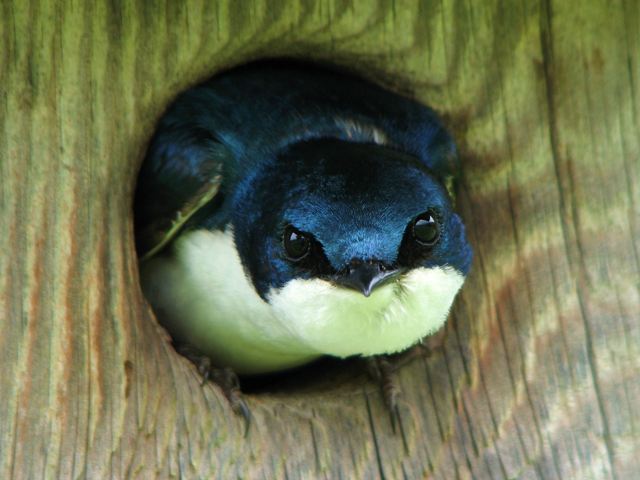To understand why anthropogenic noise has the potential to
negatively impact animals--a topic visited often here on Anthrophysis--it’s helpful to know a bit about signal detection
theory (SDT). First applied to animal behavior by bioacoustician extraordinaire Haven Wiley, SDT
recognizes that it can be biologically costly either to miss an important
signal or to respond to
one that you shouldn’t. The presence of anthropogenic noise makes the former scenario
more likely because it threatens to mask relevant sounds. Animals may react to
this by “lowering their response threshold,” or responding more readily to any
sound that seems remotely important—thus leading to the latter scenario. Both
can have serious negative implications.
Such errors are particularly likely in juveniles learning
the ropes of acoustic communication. Nestling birds, which use acoustic signals
to determine when they should beg for food from their parents, may fail to respond to
the adults' audible arrivals as often as 20% of the time, and may
accidentally beg to a non-parental noise as much as 50% of the time. The first
mistake could cost them a meal, and, if passing predators use the vocalizations
to locate and prey on a nest, the second could cost their lives.
(Tree swallow, Tachycineta bicolor, peeking out of its nest box)
The likelihoods of these different scenarios were recently
investigated by two biologists from Nova Scotia’s Dalhousie University. Using tree swallows (Tachycineta
bicolor) as their focal species, the researchers quantified whether the presence of environmental
noise increases the frequency of begging errors. To do this, they found 28
swallow nests with 4 chicks apiece; once the chicks reached 10-12 days of age, two individuals per nest were allocated to a noise treatment, while the other two
were used as controls. For each trial, pairs of birds were removed from their
home nest box and placed in an unoccupied "test" box. For
one hour, chicks in the test box were either exposed to 65 dB of white noise (noise
treatment) or left alone (control). During the next 20 minutes, while the
original acoustic conditions continued, the birds were also exposed to 7
presentations of 3 audio recordings: a parent landing on a nest box and
uttering a contact call to stimulate begging; a parent landing on a box but
making no additional sounds; and a potential predator (common grackle, Quiscalis versicolor) landing on the
nest box. Each trial was filmed, and the researchers later watched the
resulting videos in order to observe the amount of begging the chicks performed
in response to the different stimuli and ambient noise conditions.
As predicted, nestlings begged more often to the
parent-with-call stimulus (96% of trials) than to the parent-without-call
stimulus (54% of trials). Responses to both stimuli were significantly lower
among birds in the noise treatment, indicating that the parental acoustic
signals were being masked. However, chick
response levels to predator noises were similar (35%) in both the noise and
control treatments. This suggests that noise-exposed birds had not lowered
their response thresholds in response to the ambient noise conditions.
(Common grackle, Quiscalis versicolor)
Chicks that delay, or
fail to perform, a begging display in response to a parent’s arrival risk being
outcompeted by a more vociferous sibling; thus, it is important to respond both
quickly and loudly once an adult lands at the nest box. Although there may be
significant costs associated with failing to beg appropriately, it may be even
worse to “jump the gun” and beg in response to noises that turn out to have
been made by a non-parent. This may be why the tree swallows in this study
failed to lower their response threshold despite the presence of noise
pollution. However, the authors point out the possibility that there may be
other mechanisms by which the negative impacts of noise are mitigated—for
instance, the presence of “visual or tactile cues…[that] signal parental
arrivals,” or the use of post-arrival parental vocalizations to stimulate
begging.
In a previous study on nestling tree swallows, these same
two researchers found that noise-exposed chicks did not suffer any decreases in
feeding or growth rates. Thus, even if reductions in signal detection lead to
missed feedings or redistribution of parental care among different siblings,
this does not appear to have any long-term consequences chicks of this species.
However, the scientists suggest that nestlings may owe their good health to
their parents—who might compensate for noise-induced feeding problems by
expending additional energy on chick care, spending less time looking after
their own needs, or both; similar patterns have been reported for birds exposed
to other types of anthropogenic disturbance.
(Tree swallow nestlings in their feather-lined nest box)
The many remaining questions associated with this topic
reveal just how much there is to learn about anthropogenic noise and its
effects on wildlife. For instance, it will be vital to evaluate whether younger chicks (who rely more
on acoustic cues until their eyes open at ~day 5) are more susceptible to
ambient noise, to quantify whether noise disturbance is particularly costly to
adults attempting to rear broods, and to perform studies on additional breeding
bird species.
---
Leonard, M.L. and Horn, A.G. 2012. Ambient noise increases missed detections in nestling birds. Biology Letters, online advance publication.
Thanks to the following websites for providing the images used in this post:
http://www.carolinabirdclub.org/gallery/Lewis/tres_2.html
http://billhubick.com/photos/birds/common_grackle.php
http://meadowblog.typepad.com/mblog/2008/07/tree-swallows-a.html



No comments:
Post a Comment